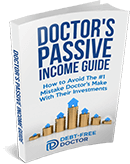How to Earn Passive Income in Real Estate Investing
If you’re new here, I’m Dr. Jeff Anzalone—a periodontist who used to rely 100% on active income from my practice. Like many high-income professionals, I thought the only path to retirement was grinding away for 30+ years, maxing out my 401(k), and hoping it would be enough.
That all changed when I discovered passive income through real estate investing.
Now, I help other professionals build income streams that work for them, not the other way around. Through real estate syndications and other passive strategies, I’ve been able to reduce my clinical days, spend more time with family, and create true financial freedom.
In this article, I’m going to walk you through what passive income real estate investing really is, how it’s different from active investing, and how you can start building consistent income without taking on a second job or becoming a landlord.
Let’s dive in.
Don’t Miss Any Updates. Each week I’ll send you advice on how to reach financial independence with passive income from real estate.
Sign up for my newsletterWhat Is Passive Income Real Estate Investing?
Passive income real estate investing is a strategy where you earn money from real estate without handling the day-to-day responsibilities of managing properties. It’s not about flipping houses or taking midnight calls from tenants. Instead, it’s about finding investment structures that generate monthly income while you focus on your main job, family, or hobbies.
When you invest passively, you’re not the landlord fixing leaky faucets. You’re the investor reviewing statements and collecting distributions. With the right investment vehicle—like real estate syndications—you can start building wealth without sacrificing your time or sanity.
Different Ways to Earn Passive Income Through Real Estate
#1. Rental Properties
Owning a rental property, like a single-family home or duplex, is one of the most common ways investors generate passive income.
When managed properly—usually by hiring a professional property manager—these investments can provide consistent monthly income. However, rental properties also come with property taxes, maintenance costs, and tenant risk.
#2. REITs (Real Estate Investment Trusts)
REITs are companies that own or finance income-producing properties. Public REITs are traded on stock exchanges, providing investors an easy way to gain exposure to commercial or residential real estate without owning physical property.
They’re simple to buy and sell, but often offer less control and typically lower yields than direct ownership or syndications.
#3, Real Estate Crowdfunding Platforms
These platforms allow individual investors to pool their money to invest in large-scale real estate projects. Most crowdfunding platforms offer both equity and debt investments in commercial properties.
Returns vary depending on the deal, but the platforms provide access to real estate for investors with less capital.
#4. Real Estate Syndications (Best for Truly Passive Investors)
Real estate syndications allow you to invest in large commercial properties, such as apartment complexes, mobile home parks, or self-storage facilities, without managing anything. You invest capital alongside others, and a sponsor team handles the acquisition, management, and eventual sale.
Syndications are popular for high-income earners who want passive cash flow, tax advantages, and long-term appreciation without being actively involved.
Active vs. Passive Real Estate Investing
The key difference between active and passive investing lies in your level of involvement. Active investors might flip homes, manage vacation rentals, or oversee short-term leases. These approaches require hands-on effort, experience, and time.
Passive investing, on the other hand, involves leveraging professionals—property managers, syndicators, or platforms—to do the work. The idea is to exchange time for expertise so that your investment produces income with minimal effort on your part.
Benefits of Passive Income Real Estate Investing
#1. Monthly Income and Cash Flow
The main appeal of passive investing is generating regular income. Whether it’s through rental payments, REIT dividends, or syndication distributions, passive real estate investments offer steady cash flow that can support your lifestyle or be reinvested for growth.
#3. Time Freedom
Passive income streams let you earn money without trading hours for dollars. That frees you up to focus on your family, your practice, or scaling your investments further.
Passive investing is especially attractive for busy professionals, like doctors or dentists, who have high earning potential but limited time.
#3. Tax Advantages
Real estate offers powerful tax advantages. You can often deduct mortgage interest, property taxes, and depreciation. In syndications, the paper losses from depreciation may offset passive income, sometimes even shielding other income depending on your tax situation.
REITs and crowdfunding may also provide tax-advantaged income depending on the structure.
Long-Term Wealth Building
In addition to regular income, many real estate investments appreciate over time. Capital appreciation, reinvested returns, and compounding rental income all contribute to wealth creation.
Syndications often target a 5- to 7-year hold period, during which the value of the property increases, providing a lump sum return on the backend.
Choosing the Right Property (or Strategy) for Passive Income
Residential vs. Commercial Properties
Residential properties like single-family rentals or small multifamily homes are often easier to understand and manage. They also tend to have more financing options.
Commercial properties, like apartment complexes or retail centers, usually require more capital but can produce higher yields and better scalability.
Vacation Rentals
Vacation rentals, especially in high-demand tourist areas, can generate substantial income, but they also require intensive management, marketing, and maintenance.
These properties often benefit from platforms like Airbnb, but if not managed professionally, they can quickly become active investments.
Real Estate Syndications (Again!)
Syndications remove the headaches of being a landlord. You don’t pick tenants, collect rent, or worry about the water heater breaking. You partner with experienced operators who handle everything, and you earn a preferred return plus a share of the upside when the property sells.
It’s one of the most truly passive ways to invest in real estate.
Scaling Your Passive Income Strategy
Start Small, Think Long-Term
You can start with a single rental or a small investment in a REIT or crowdfunding platform. But the real magic happens when you reinvest your earnings.
Whether it’s using refinancing strategies, portfolio rebalancing, or compounding cash flow into more deals, scaling lets you move from a few hundred dollars a month to a full-blown income stream that replaces your W-2.
Financing and Leverage
Financing can accelerate your growth. Mortgages, lines of credit, or even partnerships give you more buying power.
But leverage comes with risk, especially if interest rates rise or rental income drops. Smart investors use conservative debt, maintain reserves, and keep their cash flow strong.
Diversification Across Property Types and Markets
Don’t keep all your eggs in one basket. Diversifying across property types (residential, self-storage, RV parks, etc.) and regions protects against local downturns. Syndications often do this for you by offering access to different markets and asset classes under one umbrella.
Related: Why I Invest in RV Parks: Unlocking High Returns & Income Streams
Don’t Miss Any Updates. Each week I’ll send you advice on how to reach financial independence with passive income from real estate.
Sign up for my newsletterTechnology Has Changed the Game
Modern platforms make it easier than ever to invest passively. From mobile-friendly crowdfunding portals to automated property management apps, technology removes many of the traditional barriers.
Crowdfunding and Online Platforms
Platforms like Fundrise or RealtyMogul let you invest with as little as $500 in real estate deals that used to require six-figure commitments.
These portals handle the paperwork, property management, and reporting, keeping things passive.
Real-Time Analytics and Dashboards
Many platforms now offer dashboards that show your returns, property performance, and investment updates—all at a glance. These tools help you track your investments without needing to dig through spreadsheets or attend endless meetings.
Common Challenges and Misconceptions
“Set It and Forget It” Isn’t Always Real
While passive investing is much less time-intensive than active investing, it still requires occasional oversight. You’ll want to check your distributions, monitor market conditions, and evaluate whether it’s time to reinvest or exit.
Passive income doesn’t mean zero involvement—it means less involvement.
Risk Still Exists
All real estate carries risk. Markets can shift, tenants can stop paying, and properties can underperform.
That’s why due diligence is key, especially with syndications or crowdfunding. Ask questions, review the sponsor’s track record, and understand your downside.
Overestimating Returns
Many people see advertised returns and assume those are guaranteed. They’re not. Past performance isn’t a predictor of future results.
Your income may vary, and exit values can change based on interest rates, economic cycles, or unexpected costs.
Final Thoughts: Is Passive Income Real Estate Investing Right for You?
Passive income real estate investing can be a game-changer, especially for those who want to escape the time-for-money trap. Whether you’re earning rental income, investing in REITs, or diving into syndications, the right strategy can support your financial goals while freeing up your time.
If you’re new, start with what fits your risk tolerance and experience level. As you gain confidence, scale up. And if you’re looking for a path to financial independence that doesn’t involve late-night plumbing emergencies, real estate syndications might be your best-kept secret.
So whether you’re planning for retirement, aiming to replace your W-2 income, or just want some extra cash flow, there’s never been a better time to start building passive income streams through real estate.
Join the Passive Investors Circle


